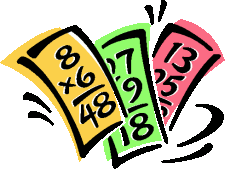Using Flash Cards to Remember Information
 Flash cards are a powerful tool that can help you remember information such as the meanings of vocabulary words, mathematical formulas, history facts, and the correct spelling of words.
Flash cards are a powerful tool that can help you remember information such as the meanings of vocabulary words, mathematical formulas, history facts, and the correct spelling of words.
Here are some strategies to help you get the most benefit from using flash cards.
- Make flash cards as you learn and study.
Carry a stack of blank cards with you (3″ x 5″ size works well). Whenever you come across a piece of information you want to remember, write the information on a card. Organize your cards into decks, one for each subject or topic. If you place cards for different subjects or topics in the same deck, you will only become confused. - Use both sides of a card when appropriate.
When learning a new vocabulary word, for example, write the word to be learned on the front of the card and a short two or three word definition on the back of the card. For a historical fact, for example, you might write “George Washington” on the front and “first U.S. president” on the back. Flip the cards over from time to time. Sometimes you will see “George Washington” and will have to remember that he was the first president of the U.S. Other times you will see “first U.S. president” and will have to remember that it was George Washington. Doing this will strengthen your recall of the information. - Use flashcards in several different colors.
Use colors as cues to help you recall a distinctive characteristic about the information on a flash card. For example, if you are using flash cards to remember vocabulary words, use a different color for words that have different connotations. Positive words such as delightful, excellent, and nutritious could go on green or blue cards. Negative words such as resentful, suspicious, and threatened could go on red or yellow cards. You can use neutral colors such as white or tan for words that are neutral (words that are not positive or negative). The particular colors you choose don’t matter as long as you are consistent in their use. - Illustrate the cards.
Draw pictures on a card or cut pictures from a magazine and paste them on the card. The more you work at making a card distinctive and interesting, the easier you will find it to recall the information on the card. - Don’t put too much information on any one card.
The biggest mistake students make is putting too much information on a single flash card. Each card should contain just one piece of information.  Carry your cards with you.
Carry your cards with you.
Review your cards whenever you have a chance. For example, you can review your cards while eating a meal, riding on the school bus, waiting on a line, during long trips, in bed before you go to sleep, and so on. Make reviewing your cards a daily habit like brushing your teeth or taking a shower.- Change the order of the cards frequently.
Shuffle the cards each time you review them. Questions on a test about the information on your cards may come in any order. If you always study the cards in the same order, it will be difficult for you to remember a piece of information when it is not in the order you studied.
Flash cards are easy to make and easy to use, and they are a great tool for remembering information.
This article contributed by Cody Blair. His StudyProf.com website has more information about flashcards and other study skills.
